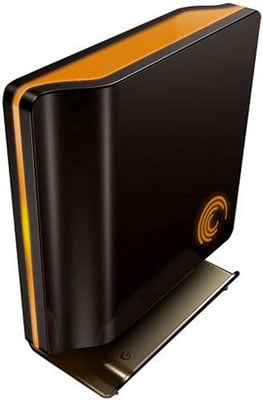This article is more than 1 year old
Seagate FreeAgent Pro 750GB external hard drive
As capacious as an elephant's scrotum - and as visually appealing?
The drive is mounted on its side. While it's fixed to the shiny black base unit, it's arranged to look like it's floating slightly above the base, giving the impression you can lift it off like an iPod from a docking cradle. You can't, which means the FreeAgent can be laid flat on your desk, a mode in which its parallelogram profile would actually look quite good, sodium glow notwithstanding.

But if the styling's all wrong, the industrial design has its moments. Seagate supplies the drive with not only USB and Firewire interfaces but the up-and-coming eSATA standard. They're not all available at the same time: the base has a screw-on panel with an eSATA connector and a mini USB socket, and there's a replacement unit in the box with two six-pin Firewire 400 ports. There are Firewire and USB cables in the box, but no eSATA line.
Swapping them round is easy enough, though while the screw that locks the panel into place is nice and large, the depth of the slot could be deeper to make it more screwdriver friendly. As it is, it's designed to be turned with no lesser tool than a US penny.
Seagate sent me the 750GB FreeAgent Pro, and with the Firewire ports plugged in I was able to connect it to my MacBook Pro and start moving data. The drive's pre-formatted for Windows users, but, to quote the packaging, "if you're a Mac person... you can reformat for Mac using Disk Utility and enjoy all those glorious gigabytes". Please.
I didn't reformat the drive because I wanted to connect it to my Windows XP machine later. In fact, it's formatted using the Windows NT file system, and Mac OS X said I didn't have sufficient permission to write to it, so I reformatted it to FAT32 for compatibility.
Next, some tests. I created a 100MB file, duplicated it nine times, popped 'em into a folder and then copied that five times to create a 5GB folder containing 50 items. This I copied first to the FreeAgent, then duplicated on the drive itself, before copying the data back. In each case, the time was averaged over three runs.
Copying over the data took 4m 32.96s, or 18.32MBps. Duplicating the data on the drive took 5m 14.57s, or 15.9MBps. So by no means unreasonable for a 7,200rpm external drive, quite quick, in fact.
I also tried Sonnet Technologies' Tempo ExpressCard add-in to try the drive's eSATA connection. Speed-wise, the results were near enough the Firewire figures as makes no odds: 18.56MBps for copying to the drive. That said duplication on the drive happened at a rate of, on average, 25.4MBps, well above Firewire speeds, which is handy if you plan to use the drive as a Photoshop scratch disk, for example.
